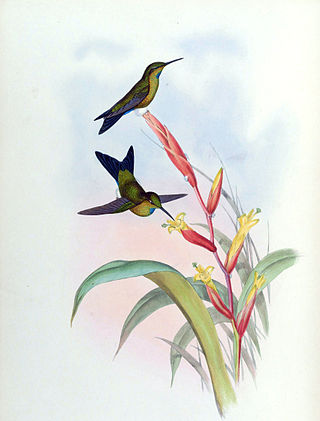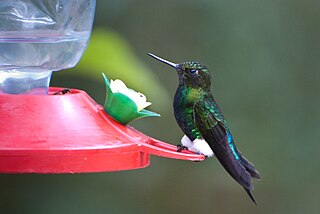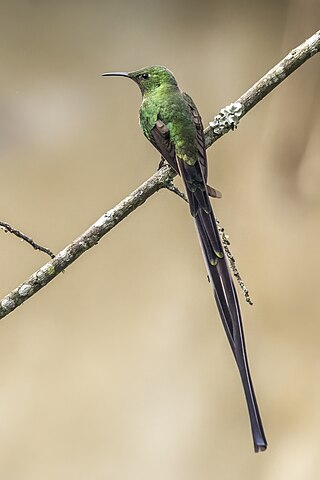
The marvelous spatuletail is an endangered species of hummingbird in the "brilliants", tribe Heliantheini in subfamily Lesbiinae. It is endemic to northern Peru.

The turquoise-throated puffleg, also known as Godin's puffleg, is a species of hummingbird from Ecuador. It is mostly green with blue undertail coverts and white powder-puffs of downy feathers on the legs, and the male has a bluish-purple throat patch. It is only known from a few specimens taken in the nineteenth century and its taxonomic position is unclear. The type of habitat in which the type species was obtained has largely disappeared, and recent surveys trying to find this bird have failed. The International Union for Conservation of Nature believes it may be extinct, but there is a possibility that some individuals remain, so the bird has been rated as "critically endangered".

Eriocnemis is a genus of hummingbirds, which - together with the species in the genus Haplophaedia - are known as pufflegs. They occur in humid forest, woodland and shrub at altitudes of 1000 to 4800 m. asl in the Andes of Argentina, Bolivia, Peru, Ecuador, Colombia, and Venezuela. The males have a colourful green, coppery or blue plumage, and the females are generally somewhat duller. The most striking feature of both sexes in the genus Eriocnemis are their dense snow-white leg-puffs which consist of feather tufts that resemble woolly panties. One species, the black-thighed puffleg - is characterized by black coloured leg-puffs. Most have a contrasting blue, purple or coppery-red vent, but this is green in the black-thighed and emerald-bellied puffleg. Further common features of all species are the straight black bill and the slightly to deeply forked tail. The genus name was coined by the German naturalist Ludwig Reichenbach who called them Snowy panties.

The colorful puffleg is an Endangered species of hummingbird in the "brilliants", tribe Heliantheini in subfamily Lesbiinae. It is endemic to Colombia.

The fawn-breasted brilliant is a species of hummingbird. It is native to South America, where it occurs in Bolivia, Colombia, Ecuador, and Peru.

The gorgeted puffleg is a Critically Endangered species of hummingbird in the "brilliants", tribe Heliantheini in subfamily Lesbiinae. It is endemic to Colombia. It was discovered in 2005 and confirmed as a species new to science in 2007.

The Esmeraldas woodstar is a rare, neotropical species of hummingbird in the family Trochilidae. There are six different species in the woodstar genus. Most of them are poorly studied due to their small size, extremely similar resemblance to each other, and rarity. Esmeraldas woodstars are one of the smallest bird species. They are sexually dimorphic. The main difference between sexes is that males have a bright purple throat. Esmeraldas woodstars are found only on the Pacific coast of west Ecuador in semi-deciduous to evergreen forests. They feed on the nectar of flowering shrubs and trees. The main threat to this species is deforestation. Esmeraldas woodstars are Vulnerable and require habitat protection.

The blue-mantled thornbill is a species of hummingbird in the "coquettes", tribe Lesbiini of subfamily Lesbiinae. It is found in Bolivia, Ecuador, and Peru.

The emerald-bellied puffleg is a species of hummingbird in the "brilliants", tribe Heliantheini in the subfamily Lesbiinae. It is found in Colombia, Ecuador, and Peru.

The coppery-bellied puffleg is a species of hummingbird in the "brilliants", tribe Heliantheini in subfamily Lesbiinae. It is found in Colombia and Venezuela.

The black-thighed puffleg is a species of hummingbird in the "brilliants", tribe Heliantheini in subfamily Lesbiinae. It is found in Colombia and Ecuador.

The blue-capped puffleg is a species of hummingbird in the "brilliants", tribe Heliantheini in subfamily Lesbiinae. It is found in Argentina and Bolivia.

The sapphire-vented puffleg is a species of hummingbird in the "brilliants", tribe Heliantheini in subfamily Lesbiinae. It is found in Colombia, Ecuador, Peru, and possibly Venezuela.

The golden-breasted puffleg is a species of hummingbird in the "brilliants", tribe Heliantheini in subfamily Lesbiinae. It is found in Colombia and Ecuador.

The glowing puffleg is a species of hummingbird in the "brilliants", tribe Heliantheini in subfamily Lesbiinae. It is found in Colombia, Ecuador, Peru, and Venezuela.

The greenish puffleg is a species of hummingbird in the "brilliants", tribe Heliantheini in subfamily Lesbiinae. It is found in Colombia, Ecuador, Panama, and Peru.

The hoary puffleg is a species of hummingbird in the "brilliants", tribe Heliantheini in subfamily Lesbiinae. It is found in Colombia and Ecuador.

The black-tailed trainbearer is a species of hummingbird in the family Trochilidae. It is found between 2500 and 3800m in Colombia, Ecuador, and Peru. Its natural habitats are subtropical or tropical moist montane forest, subtropical or tropical high-altitude shrubland, and heavily degraded former forest.

The purple-backed thornbill is a species of hummingbird in the "coquettes", tribe Lesbiini of subfamily Lesbiinae. It is found in Bolivia, Colombia, Ecuador, Peru, and Venezuela.
Fundación de Conservación Jocotoco is an Ecuadorian non-governmental environmental organization. It was established to purchase and protect land important to the conservation of endangered birds in Ecuador.




















